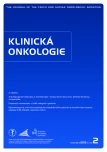Breast Cancer Adjuvant Radiotherapy Using Active Breathing Control-Moderate Inspiration Breath-Hold – a Case Report
Authors:
D. Vrána 1,2; K. Cwiertka 1; L. Lukešová 1
Authors‘ workplace:
Onkologická klinika LF UP v Olomouci, Olomouc
1; Oddělení toxikogenomiky, Centrum toxikologie a zdravotní bezpečnosti, Státní zdravotní ústav, Praha
2
Published in:
Klin Onkol 2013; 26(2): 143-146
Category:
Case Report
Overview
Background:
Chest movements during the breathing cycle represent a significant problem during radiotherapy of target volumes in the chest. There are several methods how to solve this problem.
Case:
We have used Active breathing control-moderate inspiration breath-hold device in the case of adjuvant treatment of breast cancer.
Results:
Comparing the DVH (dose-volume histograms) without ABC the heart dose is V25 = 6,95% = 34 cm3, V30 = 5,36%, V45 = 1,71%, D mean 6,2 Gy, however in the case of using ABC device V25 = 1,96% = 8,77 cm3, V30 = 1,26%, V45 = 0%, D mean = 2,58 Gy. The dose delivered to left lung was in the first case V20 = 31,2%, D mean = 15,9 Gy and with ABC device V20 = 26,99% a D mean 13,6 Gy. Doses deliver to right lung, cord and target volume coverage were similar in both situations.
Conclusion:
According to our experience ABC device represents simple technique how to solve problems with chest movements during radiotherapy.
Key words:
radiotherapy – adjuvant therapy – active breathing control – breast cancer – radiotherapy reproducibility
Sources
1. McNair HA, Brock J, Symonds-Tayler JR et al. Feasibility of the use of the Active Breathing Co ordinator (ABC) in patients receiving radical radiotherapy for non-small cell lung cancer (NSCLC). Radiother Oncol 2009; 93(3): 424–429. Epub 2009 Oct 23.
2. Kubecová M. Radioterapie karcinomu prsu. Onkologie 2009 : 3(1): 28–31.
3. Clarke M, Collins R, Darby S et al. Early Breast Cancer Trialists’ Collaborative Group (EBCTCG). Effects of radiotherapy and of differences in the extent of surgery for early breast cancer on local recurrence and 15-year survival: an overview of the randomized trials. Lancet 2005; 366(9503): 2087–106.
4. Stranzl H, Zurl B, Langsenlehner Tet al. Wide tangential fields including the internal mammary lymph nodes in patients with left-sided breast cancer influence of respiratory-controlled radiotherapy (4D-CT) on cardiac exposure. Strahlenther Onkol 2009; 185(3): 155–160. doi: 10.1007/s00066-009-1939-2. Epub 2009 Mar 28.
5. Ragaz J, Olivotto IA, Spinelli JJ et al. Locoregional radiotherapy in patients with high-risk breast cancer receiving adjuvant chemotherapy: 20-year results of the British Columbia randomized trial. J Natl Cancer Inst 2005; 97(2): 116–126.
6. Freedmann GM, Fowble BL, Nicolaou N et al. Should internal mammary lymph nodes in breast cancer be a target for the radiation oncologist? Int J Radiat Oncol Biol Phys 2000; 46(4): 805–814.
7. Nilsson G, Holmberg L, Garmo H et al. Distribution of coronary artery stenosis after radiation for breast cancer. J Clin Oncol 2012; 30(4): 380–386. doi: 10.1200/JCO.2011.34.5900. Epub 2011 Dec 27.
8. Paszat LF, Vallis KA, Benk VM et al. A population-based case-cohort study of the risk of myocardial infarction following radiation therapy for breast cancer. Radiother Oncol 2007; 82(3): 294–300.
9. Paszat LF, Vallis KA, Benk VM et al. A population-based case-cohort study of the risk of myocardial infarction following radiation therapy for breast cancer. Radiother Oncol 2007; 82(3): 294–300.
10. Sager O, Beyzadeoglu M, Dincoglan F et al. Evaluation of active breathing control-moderate deep inspiration breath-hold in definitive non-small cell lung cancer radiotherapy. Neoplasma 2012; 59(3): 333–340.
11. Panakis N, McNair HA, Christian JA et al. Defining the margins in the radical radiotherapy of non-small cell lung cancer (NSCLC) with active breathing control (ABC) and the effect on physical lung parameters. Radiother Oncol 2008; 87(1): 65–73.
12. Yan J, Yu JM, Li BS et al. Application of active breathing control system to precise radiotherapy for non-small cell lung cancer. Ai Zheng 2006; 25(10): 1311–1314.
13. Zhang QS, Li JB, Xu M et al. Comparison of overlap ratios of the target volume in different respiratory states with active breathing control for external-beam partial breast irradiation. Zhonghua Zhong Liu Za Zhi 2010; 32(12): 927–931.
14. Moran JM, Balter JM, Ben-David MA et al. Short-term displacement and reproducibility of the breast and nodal targets under active breathing control. Int J Radiat Oncol Biol Phys 2007; 68(2): 541–546.
15. Krauss DJ, Kestin LL, Raff G et al. MRI-based volumetric assessment of cardiac anatomy and dose reduction via active breathing control during irradiation for left-sided breast cancer. Int J Radiat Oncol Biol Phys 2005; 61(4): 1243–1250.
16. Zhong R, Wang J, Jiang X et al. Hypofraction radiotherapy of liver tumor using cone beam computed tomography guidance combined with active breath control by long breath-holding. Radiother Oncol 2012; 104(3): 379–385.
17. Claude L, Malet C, Pommier P et al. Active breathing control for Hodgkin’s disease in childhood and adolescence: feasibility, advantages, and limits. Int J Radiat Oncol Biol Phys 2007; 67(5): 1470–1475. Epub 2007 Jan 8.
18. Partridge M, Tree A, Brock J et al. Improvement in tumour control probability with active breathing control and dose escalation: a modelling study. Radiother Oncol 2009; 91(3): 325–329.
19. Umlauf J, Petrakova K, Drbal J. Radioterapie a myokard. Klin Onkol 1997; 10(3): 77–79.
Labels
Paediatric clinical oncology Surgery Clinical oncologyArticle was published in
Clinical Oncology

2013 Issue 2
Most read in this issue
- Prognostic Factors for Cervical Cancer
- Spontaneous Remission of Acute Myeloid Leukemia – a Single Center Case Reports
- A Case Report: Neutropenia Grade IV and Febrile Neutropenia in a Metastatic Breast Cancer Patient Treated With Palliative Chemotherapy Cyclophosphamide/Myocet
- The Role of Radiotherapy in the Treatment of Malignant Lymphomas – Recommendations of the Czech Lymphoma Study Group
